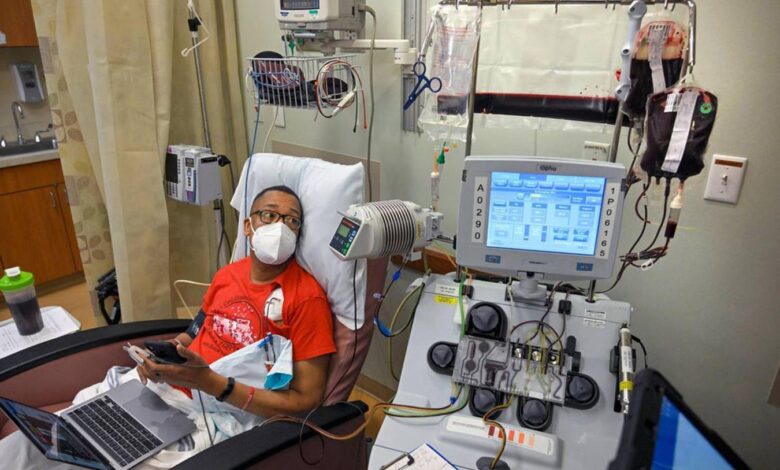Novel Access Model For Sickle Cell Disease Gene Therapy Could Be Template

📝 usncan Note: Novel Access Model For Sickle Cell Disease Gene Therapy Could Be Template
Disclaimer: This content has been prepared based on currently trending topics to increase your awareness.
Kevin Wake, 54, of Kansas City, has sickle cell disease. Every six weeks he receives blood transfusions that help alleviate the pain. Here he receives a transfusion at the Sickle Cell Center at University Health.(Tammy Ljungblad/The Kansas City Star/Tribune News Service via Getty Images)
TNS
The Centers for Medicare and Medicaid Services announced in July that 33 states, the District of Columbia and Puerto Rico will join a new voluntary program intended to improve patient access to and lower costs for gene therapies targeting sickle cell disease. This was a Biden administration initiative, which the Trump administration decided to continue to implement. It ties payment for two novel gene therapies to positive clinical outcomes. This could make such treatments that cost millions be more widely accessible for patients. And if successful, it may serve as a template for future cell and gene therapy agreements.
Medicaid, the joint federal and state program that provides health coverage to low-income individuals, is the main insurer for SCD patients. The Biden administration announced last year that the manufacturers of Lyfgenia and Casgevy had entered into agreements with CMS to participate in the Cell and Gene Therapy Access Model, which allows CMS to negotiate outcomes-based agreements on behalf of state Medicaid programs for cell and gene therapies, beginning with sickle cell disease treatments. Essentially this means that CMS will reimburse based on whether certain agreed-upon clinical thresholds are reached in patients.
According to CMS, the participating states in the newly established access initiative represent about 84% of Medicaid beneficiaries with SCD. The program could contribute towards a sizable expansion of access to potentially transformative care in the form of two extraordinarily expensive gene therapies. The launch prices for Casgevy (exagamglogene autotemcel) and Lyfgenia (lovotibeglogene autotemcel) were $2.2 million and $3.1 million, respectively.
SCD is a group of congenital red blood cell disorders, named sickle cell for their crescent shape. The condition affects millions of people worldwide. In the United States, approximately 100,000 individuals are living with the disease, which predominantly impacts people of sub-Saharan African descent.
The disease alters the structure of hemoglobin, the molecule in red blood cells that delivers oxygen to organs and tissue throughout the body. As a consequence, this causes severe pain, anemia, organ damage and infections. Individuals with the disease have a shorter life expectancy, by more than 20 years on average. The most common sickle cell disorder type is sickle cell anemia.
Besides pain medications to relieve symptoms as well as antibiotics to treat infections, hydroxyurea—a bone marrow suppressive agent that decreases red blood cell production—can be used to reduce the frequency of painful episodes. It has been in use since the 1980s. The Food and Drug Administration has approved several new therapeutics in the past ten years, but none are as promising as Lyfgenia and Casgevy. These two novel therapies can decrease or potentially eliminate pain crises in patients.
Gene therapies such as Lyfgenia and Casgevy are administered in an inpatient hospital setting but are considered covered outpatient drugs because they’re directly reimbursed and subject to standard, federally mandated Medicaid rebates. Manufacturers of the two treatments must also provide states with supplemental rebates (post-hoc discounts off of the list price) reflecting model-negotiated terms. In turn, states are obligated to implement an agreed-upon access policy for patients.
According to CMS, there is also optional federal support of up to $9.55 million per state available to help with implementation of the arrangements, outreach and data tracking.
In the cell and gene therapy space, science has generally outpaced commercialization. Access to very costly treatments is a challenge. Whether in the public or commercial sector, payers must find novel ways of paying for cell and gene therapies while generating evidence with respect to their real-world effectiveness and safety. Questions insurers must find answers to include: What are the health outcomes for patients in real-world settings? Do treatments fulfill the promise of a one-time cure for certain serious illnesses or disorders? Are there particular safety concerns that appear in real-world settings? Are side effects manageable?
Coordinating evidence gathering as well as contracts across state Medicaid agencies is likely to yield a more efficient process while improving access for a substantial majority of SCD sufferers nationwide.
It’s not just SCD gene therapies that confront a formidable set of barriers to access. All cell and gene therapy manufacturers face a challenging environment. The regulatory hurdles are enormous to begin with, but manufacturing challenges following approval are considerable, too. Furthermore, patient preparation, side effect and adverse event profiles can be intolerable. This can deter patients from signing up to initiate treatment. On top of all of this, payers concerned about the high per unit costs often impose coverage restrictions, as the Tufts Center for the Evaluation of Value and Risk in Health describes.
Nonetheless, gene therapies in particular hold the promise of delivering groundbreaking improvements in health outcomes across multiple disease areas. Therefore, overcoming obstacles to optimal patient access is crucial. If successful, the SCD model being experimented with could serve as a blueprint for other cell and gene therapies that have faced considerable barriers with respect to patient access.




